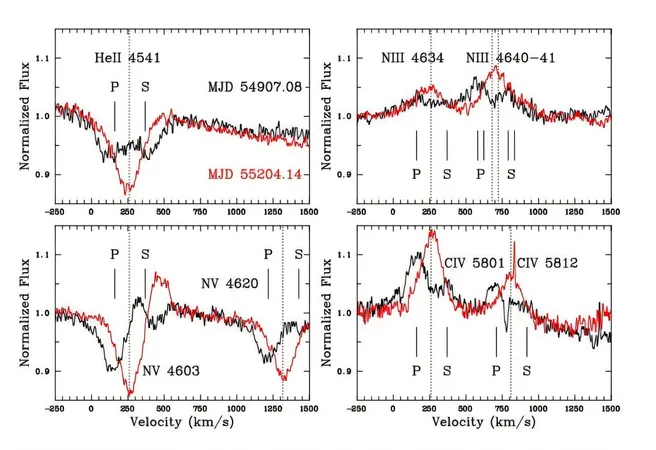
Melnick 39: Astronomers Unravel Secrets of a Massive Colliding-Wind Binary System!
2025-03-31
Author: Jia
Introduction
In a groundbreaking study, astronomers from the University of Sheffield and Pennsylvania State University have unveiled new insights about the massive star system Melnick 39, located in the Tarantula Nebula of the Large Magellanic Cloud. Their observations, made using X-ray and optical technologies, confirm that Melnick 39 is a colliding-wind binary system comprised of two extraordinary O-type supergiant stars—an astronomical discovery detailed on March 21 on the pre-print server arXiv.
Characteristics of Melnick 39
These massive stars are not only strikingly luminous, but they also produce remarkably fast stellar winds with speeds ranging between 1,000 to 3,000 km/s. Among evolved massive stars, Wolf-Rayet (WR) stars, like Melnick 39, exhibit even more intense winds after shedding their hydrogen-rich layers—these winds play a significant role in the formation of X-ray emissions through various shock mechanisms, including interactions within a binary system.
Mass and Brightness
Melnick 39, originally identified as a WR star in the Tarantula Nebula, is notable for its immense mass, estimated at approximately 145 solar masses, positioning it among the most massive stars identified to date. Additionally, it stands out as one of the brightest X-ray sources within the Nebula.
Binary System Confirmation
Prior studies hinted that Melnick 39 might be part of a binary system, with preliminary orbital estimates suggesting a cycle of 92.6 days. The latest research, led by astronomer Andrew Pollock, confirms these suspicions and offers further specifics: Melnick 39 is classified as a double-lined O2.5 If/WN6+O3 V–III spectroscopic binary with an orbital period near 648 days.
Mass and Temperature of the Stars
The groundbreaking paper indicates that the two stars within Melnick 39 exhibit minimum masses of 105 and 80 solar masses, showcasing a mass ratio of 0.76. Furthermore, the stars have effective temperatures of approximately 44,000 K and 48,000 K, respectively. Impressively, the primary star is believed to be around 1.5 million years old, while its companion is around 400,000 years younger. Calculations suggest stellar wind velocities for both components hover around 2,600 km/s.
X-ray Luminosity Characteristics
Significantly, the study found that Melnick 39’s X-ray luminosity corresponds inversely to the separation between the binary stars, which is characteristic of colliding-wind binaries in what's known as the adiabatic regime. As the astronomers noted, Melnick 39 reaches a peak count rate near 10 counts/ks at its closest orbital approach of roughly 3.5 AU, an impressive measurement that can be compared to Melnick 34, the brightest colliding-wind binary observed by the Chandra X-ray Visionary Project, which records a significantly higher count rate at minimum separation.
Implications of the Findings
The implications of such findings are substantial. Melnick 39 not only enhances our understanding of the life cycles of massive stars but also sheds light on cosmic phenomena associated with binary systems. As researchers continue to analyze this extraordinary system, who knows what additional secrets the universe will reveal? Stay tuned for more revelations from the depths of our cosmos!
 Brasil (PT)
Brasil (PT)
 Canada (EN)
Canada (EN)
 Chile (ES)
Chile (ES)
 Česko (CS)
Česko (CS)
 대한민국 (KO)
대한민국 (KO)
 España (ES)
España (ES)
 France (FR)
France (FR)
 Hong Kong (EN)
Hong Kong (EN)
 Italia (IT)
Italia (IT)
 日本 (JA)
日本 (JA)
 Magyarország (HU)
Magyarország (HU)
 Norge (NO)
Norge (NO)
 Polska (PL)
Polska (PL)
 Schweiz (DE)
Schweiz (DE)
 Singapore (EN)
Singapore (EN)
 Sverige (SV)
Sverige (SV)
 Suomi (FI)
Suomi (FI)
 Türkiye (TR)
Türkiye (TR)
 الإمارات العربية المتحدة (AR)
الإمارات العربية المتحدة (AR)